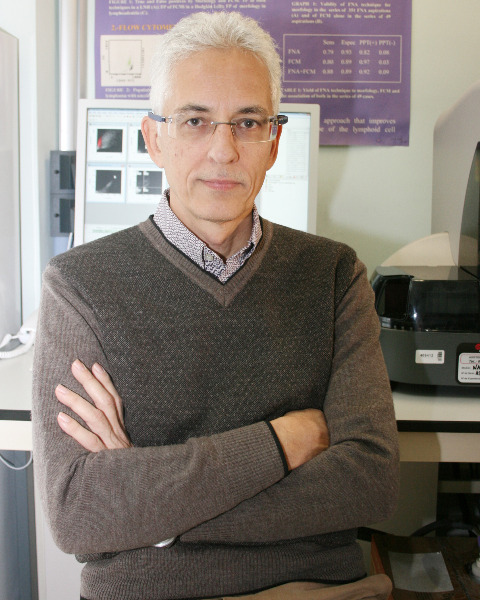Treatment of Relapsed/Refractory Myeloma
Poster Session 2
P-243: Improved outcomes in allo-HCT for multiple myeloma patients with thiotepa-busulfan-fludarabine conditioning regimen and post-transplant cyclophosphamide, sirolimus and mycophenolate mofetil.
Thursday, September 28, 2023
12:30 PM - 1:30 PM EEST

Javier de la Rubia, Prof. Dr. (he/him/his)
Head of Department
Hematology Department, University Hospital La Fe
Valencia, Comunidad Valenciana, Spain
Introduction: The use of allogeneic hematopoietic stem cell transplantation (allo-HCT) in the treatment of multiple myeloma (MM) is a matter of ongoing controversy due to the transplant-related mortality (NRM) and relapse rate. Despite these limitations, efforts to improve supportive care measures, less toxic conditioning regimens, and more effective strategies to prevent graft-versus-host disease (GVHD) are being made to enhance the success of allo-HCT in MM.
Methods: This study includes 25 patients with MM from a single institution who underwent allo-HCT with thiotepa-fludarabine-busulfan (TBF) conditioning regimen between January 2017 and December 2020. GVHD prophylaxis consisted of post-transplant cyclophosphamide (PTCy), sirolimus, and mycophenolate mofetil (MMF). Disease status at allo-HCT was defined based on the IMWG criteria. The probabilities of engraftment, acute and chronic GVHD, NRM, and relapse were estimated using the cumulative incidence method. Competing risk data were considered for different events. Kaplan-Meier estimate was used for unadjusted time-to-event analyses. GRFS analysis considered grade III-IV aGVHD, chronic extensive GVHD, relapse, graft failure, and death as events.
Results: The median age at allo-HCT was 54 years. According to R-ISS at diagnosis, 5 (20%) pts were stage I, 11 (44%) stage II, 4 (16%) stage III, and was not available in 5 (20%). Nine (36%) pts had high-risk cytogenetic abnormalities. All patients received induction therapy with novel agents, and 24 (96%) received a triple-based one. The median number of prior lines of treatment before allo-HCT was 2 (range, 1-5). Twenty-three (92%) patients had received prior auto-HCT and 8 (32%) were refractory before allo-HCT. Disease status at allo-HCT was complete response/very good partial response (n=18, 72%), partial response (PR) (n=6, 24%), and less than PR (n=1, 4%). Donor type distribution was as follows: MSD (n=12, 48%), MUD (n=7, 28%), and Haplo (n=6, 24%). Peripheral blood was the stem cell source in 23 (92%) patients. All patients engrafted. Cumulative incidence of acute GVHD grade II-IV and III-IV were 20% (95%CI, 38-70%) and 8% (1-23%), respectively. The 3-year cumulative incidence of NRM was 22% (95%CI: 3-52%) and of chronic GVHD 27% (95%CI: 11-47%). The 3-year OS, EFS, and GRFS were 74% (58-95%), 69% (52-91%), and 54% (37-79%), respectively.
Conclusions: In this real-life cohort study, allo-HCT with the TBF conditioning regimen and GCHD prophylaxis with PTCy, sirolimus, and MMF showed encouraging results. It led to reduced acute and chronic GVHD incidence, improved GRFS, and favorable survival rates. These findings suggest that this combination holds promise as an effective treatment option for MM patients considered candidates for an allo-HCT.
Methods: This study includes 25 patients with MM from a single institution who underwent allo-HCT with thiotepa-fludarabine-busulfan (TBF) conditioning regimen between January 2017 and December 2020. GVHD prophylaxis consisted of post-transplant cyclophosphamide (PTCy), sirolimus, and mycophenolate mofetil (MMF). Disease status at allo-HCT was defined based on the IMWG criteria. The probabilities of engraftment, acute and chronic GVHD, NRM, and relapse were estimated using the cumulative incidence method. Competing risk data were considered for different events. Kaplan-Meier estimate was used for unadjusted time-to-event analyses. GRFS analysis considered grade III-IV aGVHD, chronic extensive GVHD, relapse, graft failure, and death as events.
Results: The median age at allo-HCT was 54 years. According to R-ISS at diagnosis, 5 (20%) pts were stage I, 11 (44%) stage II, 4 (16%) stage III, and was not available in 5 (20%). Nine (36%) pts had high-risk cytogenetic abnormalities. All patients received induction therapy with novel agents, and 24 (96%) received a triple-based one. The median number of prior lines of treatment before allo-HCT was 2 (range, 1-5). Twenty-three (92%) patients had received prior auto-HCT and 8 (32%) were refractory before allo-HCT. Disease status at allo-HCT was complete response/very good partial response (n=18, 72%), partial response (PR) (n=6, 24%), and less than PR (n=1, 4%). Donor type distribution was as follows: MSD (n=12, 48%), MUD (n=7, 28%), and Haplo (n=6, 24%). Peripheral blood was the stem cell source in 23 (92%) patients. All patients engrafted. Cumulative incidence of acute GVHD grade II-IV and III-IV were 20% (95%CI, 38-70%) and 8% (1-23%), respectively. The 3-year cumulative incidence of NRM was 22% (95%CI: 3-52%) and of chronic GVHD 27% (95%CI: 11-47%). The 3-year OS, EFS, and GRFS were 74% (58-95%), 69% (52-91%), and 54% (37-79%), respectively.
Conclusions: In this real-life cohort study, allo-HCT with the TBF conditioning regimen and GCHD prophylaxis with PTCy, sirolimus, and MMF showed encouraging results. It led to reduced acute and chronic GVHD incidence, improved GRFS, and favorable survival rates. These findings suggest that this combination holds promise as an effective treatment option for MM patients considered candidates for an allo-HCT.
